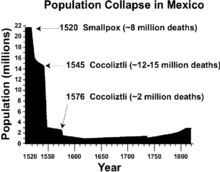Cocoliztli epidemics

The cocoliztli epidemic or The great pestilence[1] refers to millions of deaths in the territory of New Spain in present-day Mexico in the 16th century attributed to one or more illnesses collectively called cocoliztli.
The cause of the epidemic remains unknown though it might have been an indigenous viral hemorrhagic fever, perhaps exacerbated by the worst droughts to affect that region in 500 years and living conditions for indigenous peoples of Mexico in the wake of the Spanish conquest (c. 1519).[2] Some historians have suggested it was typhus, measles, or smallpox, though the symptoms did not match.[3][4] In 2018 scientists identified a rare strain of paratyphoid fever caused by the bacterium Salmonella enterica enterica as a likely cause for one outbreak.[5][6]
Etymology
The word cocoliztli originated from the Nahuatl word for "pest",[2] or disease, illness, and plague.
History

There have been 12 epidemics since thought to be of cocoliztli, with the largest being in 1520, 1545, 1576, 1736, and 1813.[8]
Cocoliztli epidemics usually occurred within two years of a major drought, while another disease called "matlazahuatl" appeared within two years of the rainy season. The epidemic in 1576 occurred after a drought stretching from Venezuela to Canada.[9][8] The correlation between drought and the disease has been thought to be that population numbers of the Vesper mouse, a carrier of viral hemorrhagic fever, increased during the rains that followed the drought, as conditions improved.[7]
Symptoms
According to Francisco Hernández de Toledo, a physician who witnessed the outbreak in 1576, symptoms included high fever, severe headache, vertigo, black tongue, dark urine, dysentery, severe abdominal and chest pain, head and neck nodules, neurologic disorders, jaundice, and profuse bleeding from the nose, eyes, and mouth; death frequently occurred within 3 to 4 days.[2]
Causes
The causes of the epidemic remain unknown; It has been speculated that it might have been an indigenous viral hemorrhagic fever, perhaps exacerbated by the worst droughts to affect that region in 500 years and living conditions for indigenous peoples of Mexico in the wake of Spanish conquest (c. 1519).[2] Some historians have suggested it was typhus, measles, or smallpox, though the symptoms did not match.[10][4]
In 2018, it became known that DNA from the teeth of 29 skeletons belonged to a rare strain of the bacterium Salmonella enterica enterica which causes paratyphoid fever as a likely cause.[5][6][11][12]
See also
References
- ↑ Skaarup 2015, p. 205.
- 1 2 3 4 Acuna-Soto, R; Stahle, DW; Cleaveland, MK; Therrell, MD (April 2002). "Megadrought and megadeath in 16th century Mexico". Emerging Infectious Diseases. 8 (4): 360–2. doi:10.3201/eid0804.010175. PMC 2730237. PMID 11971767.
- ↑ "La epidemia de cocoliztli de 1576" (PDF). Instituto Nacional de Antropología e Historia. Retrieved 30 November 2015.
- 1 2 Angelica Mandujano Sanchez (April 2003). "Historia de las epidemias en el mexico antiguo" (PDF). Tiempo Labirinto. Universidad Autónoma Metropolitana. p. 9-21. Retrieved 28 November 2015.
- 1 2 "500 years later, scientists discover what probably killed the Aztecs". The Guardian. AFP. 18 January 2018. Retrieved 16 January 2018.
- 1 2 Vågene, Åshild J.; Herbig, Alexander; Campana, Michael G.; Robles García, Nelly M.; Warinner, Christina; Sabin, Susanna; Spyrou, Maria A.; Andrades Valtueña, Aida; Huson, Daniel; Tuross, Noreen; Bos, Kirsten I.; Krause, Johannes (2018-01-15). "Salmonella enterica genomes from victims of a major sixteenth-century epidemic in Mexico". Nature Ecology & Evolution. doi:10.1038/s41559-017-0446-6.
- 1 2 ""Huey cocoliztli" en el México del siglo XVI: ¿una enfermedad emergente del pasado?". www.madrimasd.org. Retrieved 8 December 2015.
- 1 2 "Fiebres hemorrágicas causa de muerte en las culturas originarias". www.ciudadania-express.com. Retrieved 6 December 2015.
- ↑ "Cocoliztli y Matlazahuatl". www.zocalo.com.mx. Retrieved 6 November 2015.
- ↑ "La epidemia de cocoliztli de 1576" (PDF). Instituto Nacional de Antropología e Historia. Retrieved 30 November 2015.
- ↑ Hersher, Rebecca (16 January 2017). "Salmonella May Have Caused Massive Aztec Epidemic, Study Finds". National Public Radio. Retrieved 2018-01-17.
- ↑ "500 years later, scientists discover what probably killed the Aztecs". The Guardian. 16 January 2017. Retrieved 2018-01-17.
Bibliography
- Skaarup, Bjørn Okholm (2015). Anatomy and Anatomists in Early Modern Spain (1st ed.). Routledge. p. 205. ISBN 978-1472448262.
External links
- "Megadeath in Mexico". discovermagazine.com. Retrieved 2015-11-28.
- "'Ebola' bug wiped out the Aztecs". The Guardian. Retrieved 2015-11-28.
- "Expert: Native disease killed Aztecs, not outsiders". chron.com. Retrieved 2015-12-05.